Despite being one of the most important hops in the history of beer, the precise origins of the Fuggle variety have been a puzzle for a long time. Its genetic parentage has been a mystery, since it appeared to be unrelated to other English hop varieties, and the long-accepted story of when it was discovered, by whom, and when it was first launched turned out to be dubious at best. Now research by Czech botanists, and a Kentish local historian, has answered all the questions: it turns out that everything you have read until now, in every book and article, on the year the Fuggle hop was first launched has been wrong. In addition, the surprise answer to the exact parentage of the Fuggle hop turns out to be … well, read on.
The Fuggle is, along with the Golding variety, one of the iconic English hops, loved by brewers across Britain for more than a century for the flavours it brings to traditional bitters and milds. Equally importantly, the Fuggle hop has been widely used in breeding programmes around the world, and its descendants include some of the best-loved hop varieties of the craft beer era, including Cascade, Willamette, Citra, Nelson Sauvin, and even the new German aroma varieties Mandarina Bavaria and Huell Melon.
The long-accepted version of the origins of the Fuggle variety was laid down by John Percival, professor of botany at the South-Eastern Agricultural College, Wye, near Maidstone, Kent, more than a century ago. Writing in 1901 about the first Fuggle hop, Professor Percival said:
“The original plant was a casual seedling which appeared in the flower-garden of Mr George Stace of Horsmonden, Kent. The seed from which the plant arose was shaken out along with crumbs from the hop-picking dinner basket used by Mrs Stace, the seedling being noticed about the year 1861. The sets were afterwards introduced to the public by Mr Richard Fuggle of Brenchley, about the year 1875.”
Unfortunately, when researchers came to look at these claims in the 21st century, a number of problems were uncovered. Nobody by the name of George Stace could be found in the village of Horsmonden in or around the 1860s. Nor was it clear who of three different Richard Fuggles living in the area around that time was the one who had developed the hop that had taken his name: none of the three appears to fit the narrative very well. In addition, 1875 seemed too late for the hop’s introduction, as it was already being talked about in newspapers from that year as an established variety.
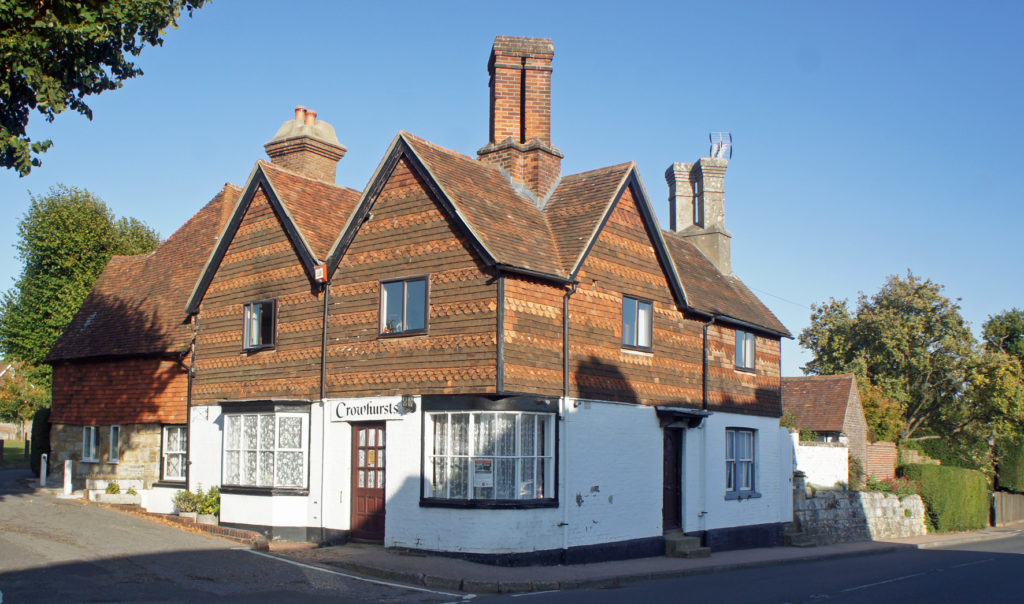
The first clue to a solution to the mystery came with the discovery some five years ago that Professor Percival had got the wrong name for the man in whose flower garden the first Fuggle hop was found. He was properly, in full, George Stace Moore, which revelation enabled his exact home, and his wife’s name, to be identified at last. George Stace Moore (known locally as just George Stace) was 55 in 1861, he lived in a cottage with a flower garden on the corner of The Heath, Horsmonden’s village green, that is still there today, diagonally across the road from the Gun Inn (now the Gun & Spitroast), and his wife, Mrs Stace, from whose dinner basket the seed that became the Fuggle hop fell among the flowers, was called Sarah, née Dadswell, aged 46.
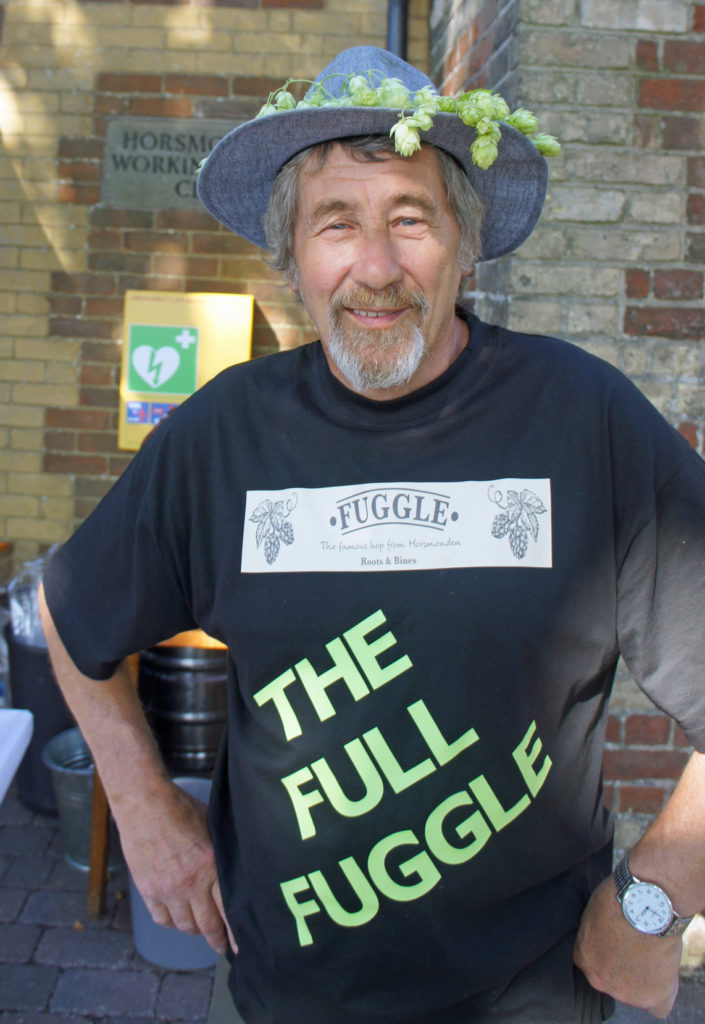
The important missing parts of that tale were finally filled in earlier this year by a local historian born in Horsmonden called Lionel Burgess. Mr Burgess discovered an advertisement from a local newspaper, the Maidstone and Kentish Journal, in October 1871 announcing the sale the following month by auctioneer William Tompsett of 100,000 bedded sets of “The new hop, known as ‘Fuggle’s Goldings'” on behalf of “Messrs Fuggle.” This was the first commercial sale of the hop that had been found in George Stace Moore’s flower garden, and it took place four years earlier than indicated by Professor Percival. Later, at least, Fuggle hop sets sold for £1 for a thousand, suggesting the brothers would make £100, less auctioneer’s fees, from the sale, worth perhaps £8,500 today. (That means, of course, that November 2021, just two years away, will be the 150th anniversary of the launch of the Fuggle hop: if we can’t get “Fugglefest 150” organised to celebrate that, I will be deeply disappointed.)
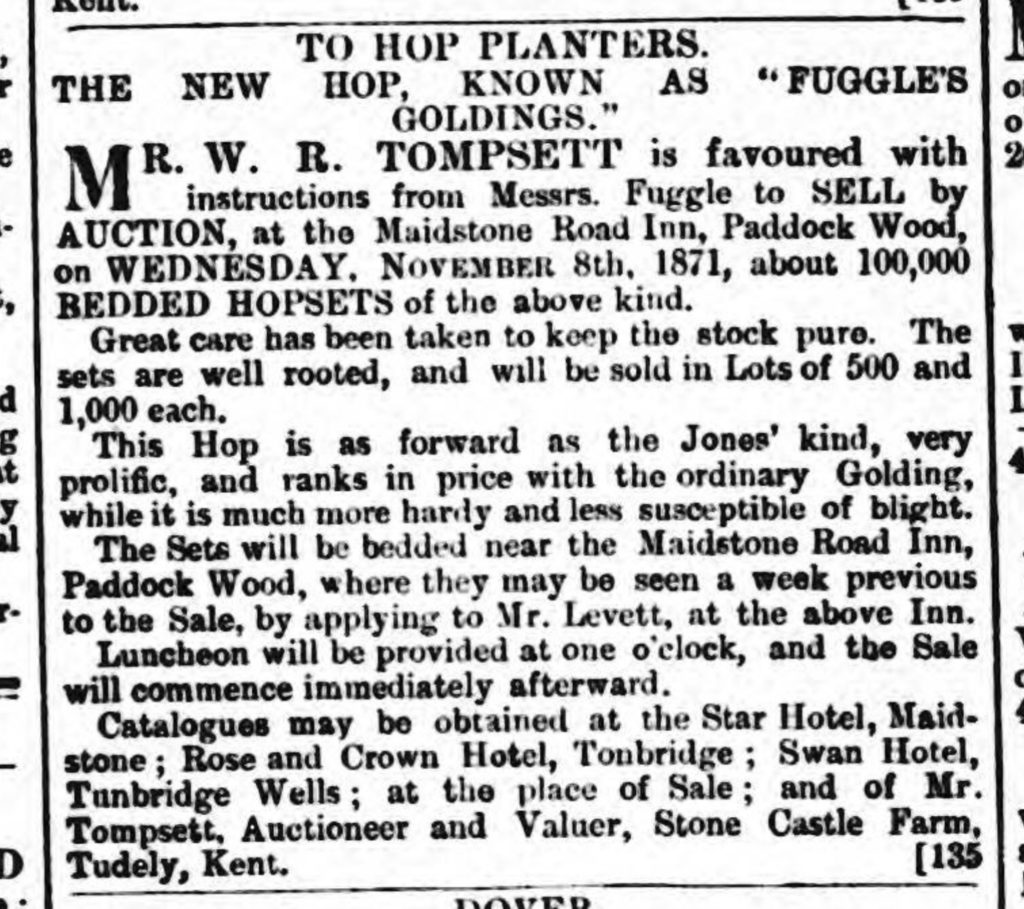
Mr Burgess was also able to identify “Messrs Fuggle”: Richard Fuggle junior of Old Hay farm, near Brenchley, and his younger brothers, John (known as Jack) and Henry (known as Harry), who were running their father’s former farm together. This identification also explains another small puzzle: why George Stace Moore did not offer the hop found in his flower garden to one of the several hop growers living closer to Horsmonden Green than the Fuggles. George and his wife were Richard Fuggle junior’s uncle and aunt. Richard junior was the son of Sarah’s sister, Ann Dadswell, who had been working as a servant for John Fuggle, father of Richard senior, at Old Hay since at least 1841, when she was 26 (it appears that she and Richard senior never actually married, despite having three children together). The family link also makes it likely—perhaps even probable—that the seed that fell out of Mrs Stace’s dinner basket got in there while she was hop picking for her relatives at Old Hay, which would put an even greater obligation on George to tell the Fuggles, and nobody else, about the extra-special hop that was growing in his flower garden.
The 100,000 Fuggle hop sets put up for sale in 1871 were bedded out near the Maidstone Road Inn, Paddock Wood. The inn later went through several changes of name, including the Railway Hotel and the Hop Pocket. It was rebuilt in the 1950s, but closed in 2007 and later demolished. However, planning permission currently exists for a new pub and an apartment block to be built on the site. By coincidence, the site where Fuggles first went on sale is only a short distance from the headquarters of English Hops Ltd, the hop growers’ co-operative, which is based in Hop Pocket Lane, Paddocks Wood.
In 1874 the Fuggle brothers dissolved their partnership as farmers at Old Hay, with an announcement appearing in newspapers that November. Strangely, the fame of their hop variety had already crossed the Atlantic, with several US newspapers, including in Vermont and Los Angeles, reporting in March 1874 that “Fuggle’s Goldings” were among “several” early kinds of hop “which have sprung up lately” that English hop growers were planting as they expanded the acreage given over to the crop. Some time between 1874 and 1878 Richard Fuggle moved from Old Hay to Wittersham, a village in Kent around 20 or so miles to the south of Brenchley. He died in 1913, being buried back in Brenchley, in the graveyard of All Saints Church, where his grave can still be seen, alongside that of his father and mother.
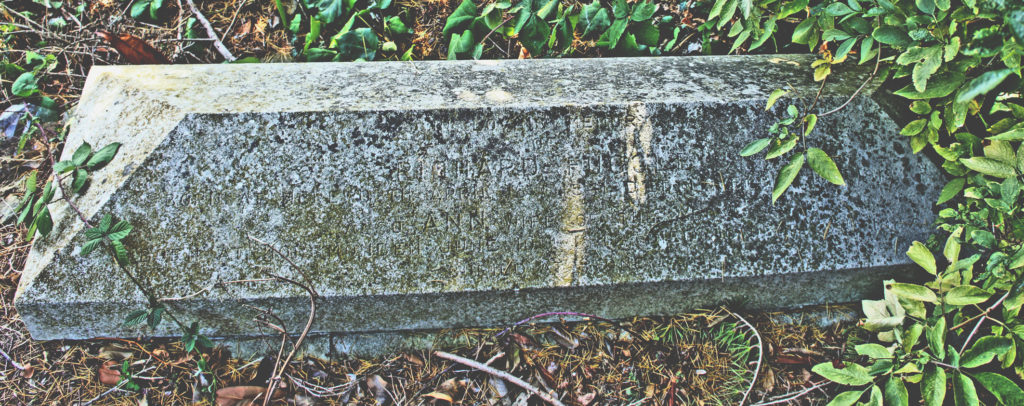
Jack Fuggle, born 1845, died in 1877, aged 32, and the youngest brother, Harry, born 1846, died the following year, aged 31: both, like their older brother, are buried at All Saints church, Brenchley. However, it remains a puzzle why Richard Fuggle moved away from the village, and why he became so obscure, despite the success of “Fuggle’s Goldings,” that Professor Percival was unable to find him, and uncover more accurate facts about the origins of the eponymous hop.
The hop variety the Fuggle brothers first sold in 1871 continued to be called by some growers “Fuggles [sic] Goldings” (and often “Fuggle’s Early Goldings,” in recognition of their cropping a week or two before other varieties) until at least 1934. In 1884, when the hop was being advertised to growers in Worcestershire, in the English Midlands, the second great hop-growing area in Britain, it was called “Fuggle’s Noted Golding.” But at the start of the 20th century most commentators were calling the variety simply the Fuggle or Fuggle’s hop, clearly feeling that it was too different from Goldings to carry the Goldings name.
That early naming of the variety as “Fuggle’s Golding”, incidentally, explains why the variety became known as Savinjski Golding, or Styrian Golding, when it was grow in Slovenia. In 1886 a local entrepreneur and activist, Janez Hausenbichler, from Savinja in what was then Austro-Hungarian Slovenia, acquired some Fuggle hop sets, at a time when the variety was still known in England as “Fuggle’s Golding.” As a result local hop farmers believed they were growing a Goldings variety, and the Fuggles grown in Slovenia became acclimatized under the name “Savinjski Golding.” The hop turned out to fit the local climate and soil perfectly and even in 1964 the Savinjski Golding was the only type of hop being grown in the Savinja Valley. When Slovenian hops started being imported into Britain, certainly by the late 1930s, the variety became known as the Styrian Golding, most likely because Britons could not pronounce “Savinjski,” and Styria was better known anyway.
Meanwhile, as growers and researchers teased out the relationships of hop varieties to one another, evidence that the Fuggles were wrong in naming their hop “Fuggle’s Golding variety”, and the Fuggle hop could not be related to the Golding hop looked to come with the discovery in 1949 by the Czech biochemist František Šorm of farnesene as a component of hop oils in some varieties of the hop plant, but not others: Fuggles contain 4 per cent or more of farnesene, Goldings have none, or at best a trace. Indeed, the hop oil make-up of the Fuggle suggested it was more similar to the German Tettnanger variety than any English hop.

However, early this year a genotype analysis was published by two more Czech researchers, Josef Patzak and Alena Henychová of the Hop Research Institute in Zatec, that showed the Fuggle brothers had been correct: their hop WAS a member of the Golding family, close enough genetically for either a mother-daughter or grandmother-granddaughter relationship. The Czech researchers tested 109 cultivars from the world hop collection at Zatec, and found that they fell naturally into three groups, “Continental European,” including the Saaz, Tettnang, Spalt and Hallertau varieties, “Island European,” including Fuggles and Goldings, and “North American.” In particular, a dendrogram of genetic distances found the Fuggle hop sitting very close to the Golding hop.
Dr Peter Darby, research director at Wye Hops Ltd, near Canterbury in Kent, told me: “A few years back, it was suggested that Fuggle was more related to the European varieties such as Tettnanger rather than the British varieties of the time such as Golding. This was based mainly on oil analysis data and the fact that Goldings have no farnesene in the oil but it is a major part of the oil of Fuggle, being about four to eight per cent of the oil content. Farnesene is also a major part of the oil of Tettnanger, comprising up to 25 per cent of its oil. Furthermore, Fuggle was known to be exactly the same genetically as Styrian Golding and Czech Green Saaz and there was a little uncertainty about which was the chicken and which was the egg.
“However, several bits of information have since clarified the situation. First, WGV [Whitbread Golding Variety] was also found to contain small amounts of farnesene, with one to two percent content. But this argument that other historic British varieties contained farnesene was always countered because WGV has wilt resistance, which suggests strongly that it arose as a seedling of a US male being grown at White’s Farm at Beltring. So its farnesene could have come in from the US father. However, at Wye our analyses of Colegate in our national collection, a variety selected in 1805, well before Fuggle, indicated that it also contains five to eight percent farnesene in its oil. Hence, farnesene does not necessarily imply non-British origin.
“But molecular methods have now confirmed Fuggle to be closely related to Golding. Four methods of molecular markers were used; SSR (simple sequence repeats), STS (sequence-tagged sites) and EST-SSR (expressed sequence tag-simple sequence repeats) and SNP (single nucleotide polymorphisms). The relationship is so close that Golding and Fuggle are likely to be within a few generations of each other – mother and daughter or granddaughter. So, the story of Fuggle arising from a seed at Brenchley is perfectly plausible. It certainly will have arisen as a seedling where Goldings were also being grown, which is not the Tettnang region.”

Today the Fuggle is struggling a little in the land where it originated: it has plunged from more than 75 per cent of all hop acreage in England at one time to less than ten per cent today, mainly because of the ravages of a disease called Verticillium Wilt, which first appeared in 1924, and to which it is badly susceptible. There is, as far as I know, only one farmer still growing the variety in Kent, Clive Edmed, of Hayle Farm, Horsmonden. (Update 12/12/19 – make that two six growers in Kent. The Fuggle hop is also grown by Hukins Hops at Haffenden Farm, St Michaels, Tenterden, and you will find the names of four more at the end of this piece.) But demand is encouraging more plantings of the variety: in 2014 the Hog’s Back brewery near Farnham in Surrey planted Fuggle hops for its own use, and in 2017 Puttenham Farm, in Seale Puttenham, also near Farnham, added to its existing 5.66 hectares of Fuggle hops another four hectares. The same year the first hops were harvested from two new yards planted with Fuggles at Orleton Court Farm in Worcestershire, 12 miles north-west of Worcester, specifically for the Yorkshire brewer Timothy Taylor. They were planted on land that had not grown hops before, and was thus free from Verticillium wilt, and which stands above the nearby River Teme, meaning it is flood-free and thus not in danger of being infected from land upstream. Richard Fuggle’s hop is looking good for a sesquicentenary celebration in 2021.
Supplier update: another hop supplier growing the Fuggle hop is Brook House Farm in Bromyard, Herefordshire.
Further supplier update: four more farms growing Fuggles in East Kent –
Thomas Johnson, Elverton Farms Ltd, Harbledown, Canterbury
Rickards Farms, Old Wives Lees, Canterbury
S.C. & J.H. Berry, Selling, Faversham
T G Redsell Ltd, Boughton-under-Blean, Faversham
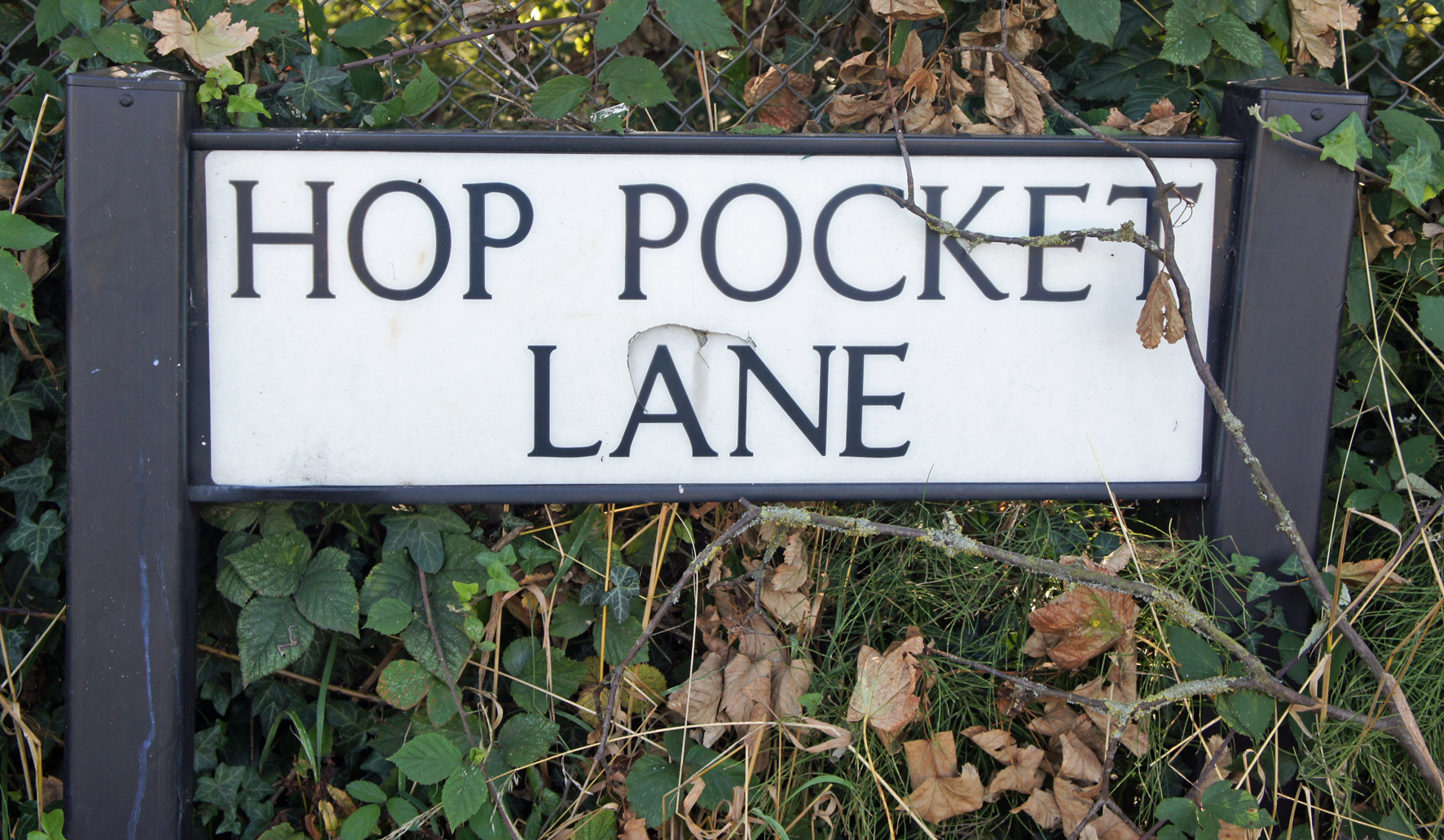

Exemplary research as always from the Master.
It would be good to see a Fuggles revival (also Bramling Cross) as a counterpoint to the, I feel, current over-dependence on American hops (nice as they are).
Fuggles are especially good if you can get hold of really fresh ones. I once brewed a 6 hectolitre batch of a golden ale using only Fuggles which had been very recently harvested not very far from the brewery, and it sold out in just over a week. It had a distinct orangey flavour and nicely balanced bitterness.
Yes, there really aren’t enough beers being made that showcase the Fuggle.
As an American homebrewer I wish I could get more Fuggle. When I do find them I usually buy several pounds but they don’t last long. EKG are even harder to find over here. At least in whole hops form. I haven’t had any of those in several years.
I used to pick hops at Puttenham Farm back in the 80s. Really hard work but enormous fun. There was a guy working on the farm, in his mid 40s (although hard to tell) who spoke with a genuine Surrey/Hampshire accent and had never been to London. He used to have a few Gales barley wines for lunch and then go back to work – we were advised to stay clear…. Cracking village pub too – The Good Intent.
Thanks for that, Simon, a great memory. You could still hear the Surrey “country” accent in Guildford in the 1980s …
Yes; when I was working at weekends on a farm just outside Guildford in the 1960s (while still in the 6th form at school), the cowman had a very rural Surrey accent. It’s something I had never heard before, or since.
An excellent article with plenty of detail.
Just a small point; I believe Orleton Court Farm (home to the Spilsbury family) is in Worcestershire, not Herefordshire. There is another village called Orleton, that is in Herefordshie, midway between Leominster and Ludlow. To add to the confusion, it has a Shropshire postcode (SY).
Thank you very much, and corrected.
this is not true martyn you arent a true fuggle master
I’m sorry – What are you on about?
These chaps,just up the road from us,https://www.hukins-hops.co.uk/hops-for-craft-beer/ are growing Fuggles and much else.
Thank you very much, and updated …
[…] Scholars of hop history have been grappling with the precise history of Fuggles, one of the most famous English hop varieties, for years. What is true and what is a handy marketing myth? Now Martyn Cornell declares ‘The surprising secrets behind the origins of the Fuggle hop uncovered at last’: […]
Great article. I do remember Whitbread doing a one-off Fuggles ale back in the 90s. Perhaps we’ll see someone else pick up the baton in 2021?
Great article! Just thought I would add that we also grow Fuggles here at Brook House Farm in Herefordshire.
Thank you very much: updated. All other Fuggle hop growers are welcome to add their names to this list.
Hi Fuggle is still grown in East Kent by 4 growers :
Myself – Elverton Farms Ltd., Harbledown
Rickards Farms, Old Wives Lees
S. C. & J. H. Berry, Selling
T G Redsell Ltd., Boughton-under-Blean
Tremendous, thank you very much, and now amended.
[…] Read more: https://zythophile.co.uk/2019/11/04/the-surprising-secrets-behind-the-origins-of-the-fuggle-hop-uncov… […]
Just found this fascinating article a few weeks late. A minor point of order. The Puttenham hop yards are in – wait for it – Puttenham, not Seale. The Hampton estate who own it are based in Seale though. I went to the Primary school next to the hop yards. Guess where our summer outing was to usually? About 20 years ago the landlord at the Good Intent told me they replanted from Goldings to Fuggles and as your article notes, they recently increased the size of the hop yard massively.
Thank you: corrected.
[…] The surprising secrets behind the origins of the Fuggle hops uncovered at last […]
[…] when I was a kid. It’s history is one that contained some mystery that was just recently revealed. Fuggle, along with the Golding hop, is a favorite hop of British brewing and has been extensively […]